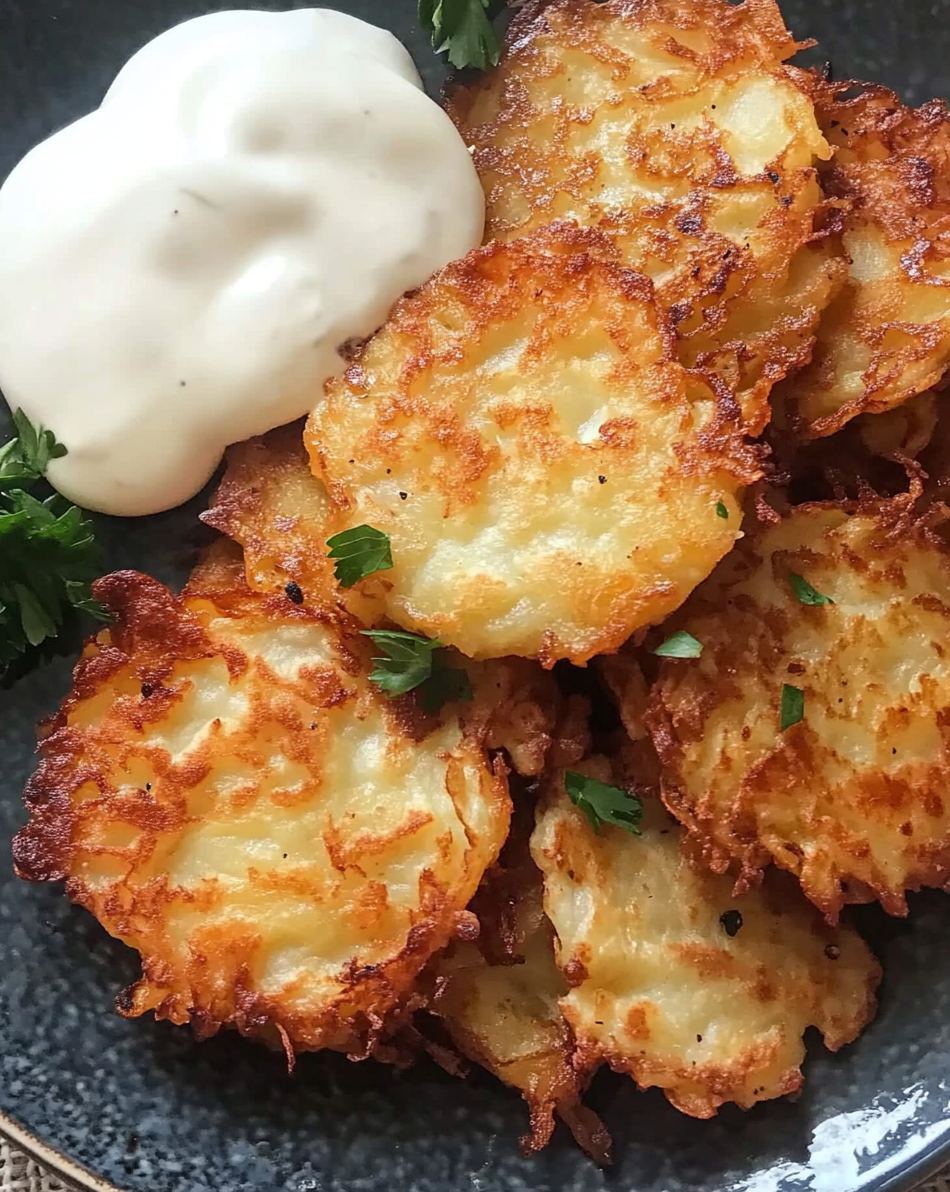Potato latkes are a deliciously crispy treat, perfect for holidays like Hanukkah or any time you crave something savory and satisfying. These golden-brown potato pancakes are made from simple ingredients like shredded potatoes, onion, and eggs, and they are fried to perfection for a crunchy exterior and a tender, flavorful inside.
Whether you serve them as an appetizer, a side dish, or a snack, latkes pair beautifully with traditional toppings like sour cream or applesauce. The simplicity of the ingredients allows the natural flavors to shine, making them a beloved comfort food in many homes.
Full Recipe:
- 2 cups shredded potatoes
- 1 small onion, grated
- 2 large eggs, beaten
- 2 tablespoons all-purpose flour
- 1 teaspoon salt
- 1/4 teaspoon ground black pepper
- 1/2 cup vegetable oil for frying
Directions:
- Begin by grating the potatoes and onion. Afterward, press out any excess moisture from the mixture using a clean towel or paper towel.
- In a large bowl, combine the shredded potatoes and onion with beaten eggs, flour, salt, and pepper. Mix until fully incorporated.
- Heat oil in a large skillet over medium-high heat.
- Form the potato mixture into small patties and carefully place them into the hot oil.
- Fry the latkes for 3-4 minutes on each side, or until golden brown and crispy.
- Once cooked, remove latkes from the pan and place them on paper towels to drain excess oil.
- Serve hot with sour cream or applesauce, as desired.
Prep Time: 15 minutes | Cooking Time: 20 minutes | Total Time: 35 minutes
Kcal: 200 kcal | Servings: 4 servings
The History and Tradition of Potato Latkes
Potato latkes are a traditional dish most commonly associated with Jewish cuisine, particularly during the celebration of Hanukkah. The custom of eating fried foods during Hanukkah is symbolic of the miracle of the oil, where a small amount of oil lasted eight days in the Jewish temple’s menorah. Latkes, which are fried in oil, serve as a delicious reminder of this historical event. While latkes are traditionally made from potatoes, they can also be made from a variety of other ingredients like sweet potatoes, zucchini, or even cheese.
Why Potato Latkes Are So Popular
One of the reasons potato latkes are so beloved is their crispy, golden texture and savory flavor. The exterior becomes perfectly crunchy when fried, while the inside remains soft and tender. They are versatile enough to be served for breakfast, lunch, or dinner and make a fantastic addition to any festive meal. Traditionally, latkes are served with applesauce or sour cream, which complements the savory flavor with a touch of sweetness or creaminess. They are often enjoyed as part of a holiday meal but are also a great comfort food year-round.
Tips for Making the Best Potato Latkes
To achieve the perfect crispy latkes, it’s essential to remove as much moisture as possible from the shredded potatoes before cooking. Excess moisture can make the latkes soggy, so squeezing the potatoes in a clean towel or cheesecloth is highly recommended. Additionally, maintaining the right oil temperature is key to achieving that golden-brown, crispy texture. If the oil is too hot, the latkes can burn on the outside while remaining uncooked on the inside. If the oil is too cool, they will absorb too much oil and become greasy.
Variations of Potato Latkes
While traditional latkes are made from potatoes, there are many variations of this beloved dish. You can mix in other root vegetables like carrots or parsnips for extra flavor or add herbs such as chives or parsley for a fresh twist. For a modern take, some people make sweet potato latkes or even gluten-free versions using alternative flours. You can also experiment with toppings, ranging from the classic sour cream and applesauce to more unique options like smoked salmon, avocado, or a poached egg.
Storing and Reheating Potato Latkes
Potato latkes are best served hot and fresh, but if you have leftovers, they can be stored in an airtight container in the refrigerator for up to three days. To reheat, place them in an oven at 350°F (175°C) for 10-15 minutes to regain their crispiness. Avoid using the microwave to reheat latkes as it can make them soggy.
Perfect for Any Occasion
Though potato latkes are traditionally served during Hanukkah, they have gained popularity worldwide as a comfort food and appetizer. They are easy to prepare, require minimal ingredients, and can be dressed up or down depending on the occasion. Whether you’re serving them as part of a holiday spread or making them for a weekend brunch, potato latkes are sure to be a crowd-pleaser.
The Cultural Significance of Latkes in Jewish Cuisine
Potato latkes hold deep cultural significance, especially in Jewish households, as they are a key part of Hanukkah celebrations. While the primary tradition of Hanukkah focuses on the miracle of the oil, the preparation and sharing of foods fried in oil, such as latkes, has become an essential part of the holiday experience. In many families, the recipe for latkes is passed down through generations, making it not only a delicious dish but also one that carries personal family histories and memories.
Regional Variations of Latkes
Interestingly, the type of latkes you encounter can vary depending on the region and family traditions. Eastern European Jews, for example, are the originators of the potato latke we know today, but prior to the widespread use of potatoes, Jews in medieval Europe made fried cheese pancakes or fritters from ingredients like buckwheat or root vegetables. Some variations of latkes from different regions include:
- Cheese Latkes: In Ashkenazi tradition, cheese latkes were made before potatoes became a staple. These are usually served with a sweet topping like jam.
- Vegetable Latkes: In addition to potatoes, other vegetables like zucchini, carrots, or beets can be used to make vibrant and colorful latkes.
- Middle Eastern and Sephardic Variants: In Sephardic Jewish traditions, fried foods like fritters, doughnuts (sufganiyot), and savory pancakes made from chickpeas or lentils are commonly served during Hanukkah instead of potato-based latkes.
Healthier Options for Latkes
While traditional potato latkes are fried in oil, which gives them that irresistible crispy texture, there are healthier variations for those who want to enjoy latkes without as much oil. Here are a few ideas for making latkes lighter:
- Baking Instead of Frying: You can bake latkes in the oven to reduce the amount of oil used. Simply brush each latke lightly with oil and bake them on a parchment-lined baking sheet at 400°F (200°C) until golden and crispy.
- Using Sweet Potatoes: Sweet potato latkes are a more nutrient-dense alternative, offering a slightly sweet flavor and vibrant orange color. They are high in beta-carotene, fiber, and antioxidants.
- Air-Frying: For an even lower-fat version, you can use an air fryer to cook latkes. They will still turn out crispy, but without the added fat from deep frying.
- Substituting Flour: If you want to make gluten-free latkes, you can substitute traditional all-purpose flour with almond flour or gluten-free flour blends.
Toppings and Serving Suggestions
One of the most exciting aspects of making latkes is deciding how to serve them. Traditional toppings include sour cream and applesauce, each bringing a contrasting flavor profile that enhances the latkes’ savory base. Here are some modern and gourmet topping ideas that can take your latkes to the next level:
- Smoked Salmon and Cream Cheese: For a luxurious take, top latkes with a smear of cream cheese, thin slices of smoked salmon, and a sprinkle of fresh dill or capers.
- Avocado and Poached Eggs: Transform your latkes into a savory brunch item by adding smashed avocado, a perfectly poached egg, and a drizzle of hot sauce.
- Beet and Horseradish Relish: This vibrant, tangy topping is a perfect contrast to the crisp latkes and adds an earthy flavor.
- Brisket or Pulled Pork: For a hearty meal, serve latkes topped with tender brisket or pulled pork. The richness of the meat pairs wonderfully with the crunchy potato base.
The Science Behind the Crisp
Achieving the perfect crispiness in latkes comes down to a few scientific principles. The key to a crispy latke is to balance the moisture content of the potatoes with the starch. Grating the potatoes releases water, and if not properly drained, it will prevent the latkes from achieving that desired crunch. Additionally, the natural starches in the potatoes help to bind the ingredients together and create a crispy outer layer when fried. The egg in the recipe also acts as a binder, and the flour absorbs any remaining moisture, helping to achieve that perfect golden-brown exterior.
Latkes Around the World
Though latkes are traditionally a Jewish dish, many cultures have their own version of fried potato pancakes:
- Swiss Rösti: In Switzerland, rösti is a popular dish made from grated potatoes, similar to latkes but often served larger and flatter. It is typically eaten as a side dish with meats or eggs.
- German Kartoffelpuffer: German potato pancakes, or kartoffelpuffer, are similar to latkes but often served with sweet toppings like applesauce or powdered sugar.
- Polish Placki Ziemniaczane: These Polish potato pancakes are very similar to latkes and are served with a variety of toppings, including sour cream, goulash, or sugar.
- Korean Gamja-jeon: This Korean version of a potato pancake is thicker and chewier than latkes and often includes other ingredients like vegetables or seafood in the batter.
Latkes in Modern Cuisine
Today, chefs and food enthusiasts are experimenting with latkes in creative and modern ways. Some restaurants offer fusion latkes, combining traditional Jewish recipes with flavors from other cuisines. For example, you might find latkes made with ingredients like kimchi, black beans, or sriracha, reflecting global food trends and adding exciting twists to the classic dish. This versatility has helped latkes become a favorite not just for Hanukkah, but for food lovers everywhere who enjoy experimenting with textures and flavors.
Conclusion
Potato latkes are a timeless and versatile dish with deep cultural roots, particularly in Jewish cuisine during Hanukkah. Loved for their crispy exterior and tender interior, they are easy to customize with various ingredients and toppings, making them a favorite for both traditional and modern palates. Whether enjoyed with classic accompaniments like sour cream and applesauce or with more creative twists, latkes are a delicious and comforting food that can be enjoyed all year round. Perfect for any occasion, they embody the joy of sharing good food with family and friends.





